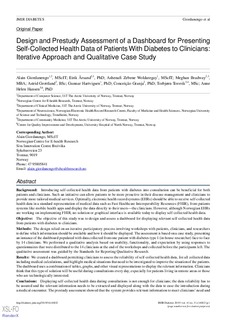| dc.contributor.author | Giordanengo, Alain | |
| dc.contributor.author | Årsand, Eirik | |
| dc.contributor.author | Woldaregay, Ashenafi Zebene | |
| dc.contributor.author | Bradway, Meghan | |
| dc.contributor.author | Grøttland, Astrid | |
| dc.contributor.author | Hartvigsen, Gunnar | |
| dc.contributor.author | Granja, Conceição | |
| dc.contributor.author | Torsvik, Torbjørn | |
| dc.contributor.author | Hansen, Anne Helen | |
| dc.date.accessioned | 2019-08-09T07:14:41Z | |
| dc.date.available | 2019-08-09T07:14:41Z | |
| dc.date.created | 2019-08-03T22:04:24Z | |
| dc.date.issued | 2019 | |
| dc.identifier.issn | 2371-4379 | |
| dc.identifier.uri | http://hdl.handle.net/11250/2607670 | |
| dc.description.abstract | Background: Introducing self-collected health data from patients with diabetes into consultation can be beneficial for both patients and clinicians. Such an initiative can allow patients to be more proactive in their disease management and clinicians to provide more tailored medical services. Optimally, electronic health record systems (EHRs) should be able to receive self-collected health data in a standard representation of medical data such as Fast Healthcare Interoperability Resources (FHIR), from patients systems like mobile health apps and display the data directly to their users—the clinicians. However, although Norwegian EHRs are working on implementing FHIR, no solution or graphical interface is available today to display self-collected health data.
Objective: The objective of this study was to design and assess a dashboard for displaying relevant self-collected health data from patients with diabetes to clinicians.
Methods: The design relied on an iterative participatory process involving workshops with patients, clinicians, and researchers to define which information should be available and how it should be displayed. The assessment is based on a case study, presenting an instance of the dashboard populated with data collected from one patient with diabetes type 1 (in-house researcher) face-to-face by 14 clinicians. We performed a qualitative analysis based on usability, functionality, and expectation by using responses to questionnaires that were distributed to the 14 clinicians at the end of the workshops and collected before the participants left. The qualitative assessment was guided by the Standards for Reporting Qualitative Research.
Results: We created a dashboard permitting clinicians to assess the reliability of self-collected health data, list all collected data including medical calculations, and highlight medical situations that need to be investigated to improve the situation of the patients. The dashboard uses a combination of tables, graphs, and other visual representations to display the relevant information. Clinicians think that this type of solution will be useful during consultations every day, especially for patients living in remote areas or those who are technologically interested.
Conclusions: Displaying self-collected health data during consultations is not enough for clinicians; the data reliability has to be assured and the relevant information needs to be extracted and displayed along with the data to ease the introduction during a medical encounter. The prestudy assessment showed that the system provides relevant information to meet clinicians’ need and that clinicians were eager to start using it during consultations. The system has been under testing in a medical trial since November 2018, and the first results of its assessment in a real-life situation are expected in the beginning of next year (2020). | nb_NO |
| dc.language.iso | eng | nb_NO |
| dc.publisher | JMIR Publications | nb_NO |
| dc.rights | Navngivelse 4.0 Internasjonal | * |
| dc.rights.uri | http://creativecommons.org/licenses/by/4.0/deed.no | * |
| dc.title | Design and Prestudy Assessment of a Dashboard for Presenting Self-Collected Health Data of Patients With Diabetes to Clinicians: Iterative Approach and Qualitative Case Study | nb_NO |
| dc.type | Journal article | nb_NO |
| dc.type | Peer reviewed | nb_NO |
| dc.description.version | publishedVersion | nb_NO |
| dc.source.journal | JMIR Diabetes | nb_NO |
| dc.identifier.doi | 10.2196/14002 | |
| dc.identifier.cristin | 1713898 | |
| dc.description.localcode | © Alain Giordanengo, Eirik Årsand, Ashenafi Zebene Woldaregay, Meghan Bradway, Astrid Grottland, Gunnar Hartvigsen, Conceição Granja, Torbjørn Torsvik, Anne Helen Hansen. Originally published in JMIR Diabetes (http://diabetes.jmir.org), 09.07.2019. This is an open-access article distributed under the terms of the Creative Commons Attribution License (https://creativecommons.org/licenses/by/4.0/) | nb_NO |
| cristin.unitcode | 194,65,30,0 | |
| cristin.unitname | Institutt for nevromedisin og bevegelsesvitenskap | |
| cristin.ispublished | true | |
| cristin.fulltext | original | |
| cristin.qualitycode | 1 | |

